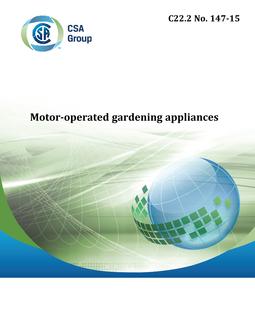
Click here to purchase
Preface:
This is the fifth edition of CSA C22.2 No. 147, Motor-operated gardening appliances, one of a series of Standards issued by the Canadian Standards Association under Part II of the Canadian Electrical Code. It supersedes the previous editions published in 1990, 1987, 1985, and 1980.
This Standard includes new requirements for leaf blower/vacuums and solid state controls as well as other general amendments. It also incorporates the requirements of the following Technical Information Letter, TIL N-35, February 3, 2014, Interim Certification Requirements for Saw-chain pole pruners.
For general information on the Standards of the Canadian Electrical Code, Part II, see the Preface of CAN/CSA-C22.2 No. 0, General Requirements—Canadian Electrical Code, Part II.
This Standard has been developed in compliance with Standards Council of Canada requirements for National Standards of Canada. It has been published as a National Standard of Canada by CSA Group.
Scope:
1.1
This Standard applies to motor-operated gardening appliances* intended for use on nominal system voltages of 250 V and less and in nonhazardous locations, and designed to be used in accordance with the Rules of the Canadian Electrical Code, Part I.
*For convenience, the short terms “appliance”, “equipment”, and “machine” are used herein.
1.2
This Standard applies to cord-connected and battery-operated lawn mowers of the reel and rotary walking types, edgers, trimmers, edger trimmers, grass shears, cultivators, shredder baggers, gardening appliances with a blower, leaf blower/vacuums, snow movers, chain saws, and similar equipment including electric starter motors for gardening appliances.
1.3
This Standard does not apply to sprayers, foggers, and other specific appliances that are covered by individual Standards of the Canadian Electrical Code, Part II.
1.4
This Standard also includes requirements for cord-connected, double-insulated gardening appliances (see Clause 7).
1.5
In this Standard, “shall” is used to express a requirement, i.e., a provision that the user is obliged to satisfy in order to comply with the standard; “should” is used to express a recommendation or that which is advised but not required; and “may” is used to express an option or that which is permissible within the limits of the Standard. Notes accompanying clauses do not include requirements or alternative requirements; the purpose of a note accompanying a clause is to separate from the text explanatory or informative material. Notes to tables and figures are considered part of the table or figure and may be written as requirements. Annexes are designated normative (mandatory) or informative (non-mandatory) to define their application.
Product Details
- Edition:
- 5th
- Published:
- 05/01/2015
- ISBN(s):
- 9781771398787
- Number of Pages:
- 81
- File Size:
- 1 file , 1.3 MB
- Product Code(s):
- 2423570, 2423570, 2423570


